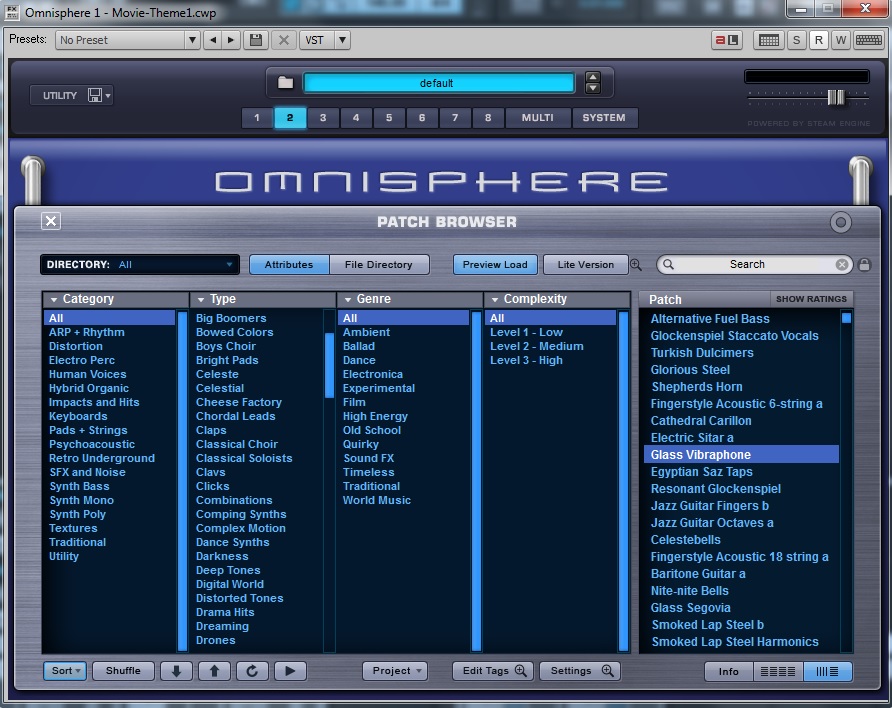One of the best aspects computer-based recording is the wide variety of Virtual Instrument plugins available for music production. Virtual Instruments are essentially software modules that provide additional instrument sounds that can be purchased as add-on modules for your computer recording software environment (a.k.a. DAW – digital audio workstation).
Tip #1: Before purchasing a Virtual Instrument plugin, make sure to check the supported plugin formats of your DAW software
Virtual Instruments use a variety of standard formats for “plugging into” your DAW environment. The most popular plug-in formats are:
- VST(Virtual Studio Technology, supported on both MacOS and Windows),
- RTAS (Real Time Audio Suite),
- AU (Audio Units for Apple OS X Core Audio)
- ReWire (an inter-application communication engine developed by Propeller Head Software).
When buying a Virtual Instrument plug-in, make sure to check the supported formats with your DAW manufacturer’s website to be sure that the plug-in supports one of the data formats supported by your DAW software. As with most other software purchases, it’s very difficult to return it to the store after you have opened the box.
The choice of Virtual Instrument for music production is mind-blowing. The more difficult part is knowing which Virtual Instruments are the best choice for your needs out of the huge assortment of them on the market today. Virtual Instruments (VI) essentially replace the use of a “real” instrument in the recording process and can also be used for live performance, in a lot of cases. VI’s are controlled/played by any midi compatible controller such as a midi keyboard, midi guitar, or even by hand-editing your own midi information in your DAW environment’s piano-roll editor. There are VIs available for nearly every musical application including synthesizers, beat-box-groove machines, orchestral instruments, re-creations of vintage keyboards, brass and horn sections, drums & percussion, ethnic instruments, bass guitars, electric/acoustic guitars, … you name it, there is a VI available for that sound. The quality of VIs is getting better all the time, only limited by user’s musical ideas and patience in taking the time to use the VI to its full capabilities.
Tip #2 Keep it real as much as you can, don’t overuse VI plugins for every sound
My overall philosophy is to use live instruments and real players as much as possible, and only use a VI plugin for those instrument sounds that I can’t play myself, or for sounds that are impossible to record in my home studio. The best approach for me is to mix my own real instrument tracks (guitars, ukulele, dobro, bass, hand percussion) along with other tracks created using VI plugins. Somehow the human element of using real instruments, recorded in a live performance, add an organic feel to the sound that helps to balance some of the mechanical-sounding aspects of some VIs. As a musician I can see how VI plugins are replacing the work that a lot of session musicians used to do. However, as a composer I’m thrilled to have the assortment of instrument sounds in my production toolbox that I can use without the need to bring real players into my home studio, setup mic’s, engineer the recording, manage the session, pay the musicians, etc.
Tip #3: When shopping for VI plugins, have your desired sounds in mind and audition the various choices from several companies. Some companies specialize in specific kinds of instruments and others offer an complete suite
As I started getting more serious about composing I set out to find the best choice of plug-ins to provide me with the following sounds that I use for many of my songs:
- Synth textures and electronica sounds
- Electronic grooves and drumbeats
- Strings, Woodwinds, Brass and other orchestral sounds
- Jazz, funk, and big-band horn sounds
As part of my search, I read lots of interviews with TV/film composers to find out which VI plugins they liked, as well as reading tons of online reviews from various users. I began to see a lot of the same manufacturer names showing up in the lists of software used by people in the industry.
Tip #4: Buy the best quality VI’s you can afford. Don’t settle for the VI’s that come pre-bundled with your DAW
After some research, I narrowed my list to a few VI plugins for the specific types of sounds I was looking for. Rather than buying all of my VI plugins from a single manufacturer (which can be more cost effective, especially when you buy a bundle of VI instruments) I cherry-picked my list of best-in-breed VI plugins for the types of sounds I wanted in my toolbox. My shortlist included:
- East West Quantumm Leap Symphonic Orchestra – one of the very best choices in the industry for orchestral sounds, if not the very best available
- Vir2 Mojo Horns – Fantastic for Jazz, Funk, and Big-band horn sounds. When used properly it’s extremely close to the real thing, mind blowing.
- Spectrasonics – Omnisphere – One of the very best synth instruments on the planet, very inspiring to use
- Spectrasonics – Stylus RMX – Killer plug-in for creating electronic grooves, makes me sound younger, more urban, and reduces signs of aging
After tallying up the cost of my new “must-have” list of plugins, and thinking of sweet things to say to my wife before spending the money, I pulled the trigger on my purchase (it wasn’t cheap!). As with so many other things in life, be prepared to pay more for high quality. If you want the best sounding and high-quality plugins, you have to pay a premium. Keep in mind that my choice of VI plugins is only my opinion, based on what I was looking for. There are plenty of other great companies out there making fantastic VIs, and my list should not be taken as a definitive “best VIs” list. Do your own research based on your needs and budget!
After receiving my new plugins and spending some time to get familiar with them, I began to realize that they stood out from my other less expensive (pre-bundled with DAW software) plugins in a few key areas:
A well-designed user interface can help you find useful sounds quickly!
This is certainly true of the Spectrasoncis plugins I’ve bought. After using Omnisphere and RMX on a few projects I could tell that the plugins were created by people that actually compose music for a living. It seems as if every feature in the plugin is made to help you get inspired, and find the right sound quickly. In addition, there are hardly any sounds in the huge library that are non-usable. By contrast, many of my cheaper VI plugins have tons of useless sounds crowding the library, making it very difficult to find a useful sound unless I am only focused on making music for the next rave party or hip-hop remix (it’s just not what I’m into). In Omnisphere there is a menu that allows you to hone in on a sound based on the emotional attributes you’re going for rather than patch name. How cool is that? This is much easier than remembering tons of patch names that often have nothing to do with the sound’s texture or emotional attributes. In Omnisphere you can type in search terms such as “suspense” or “dreamy” or along with other attributes like “organic” or “electronica” and it immediately creates a pallet of usable patches for you to audition until you find the right sound for your song. Not only does this save a lot of time, but it can mean the difference between finding a sound that is inspiring, instead of halting your creative process altogether in frustration when you spend too much time hunting for the right sound. This is especially true when you have limited time to get your work done.
Online demos are one of the best ways to audition a VI before you buy it to see if it covers the sounds and features you’re looking for. As the demo below shows, this synth has great sounds (as it should) but also it designed to inspire creative interaction with the composer, which is what I was looking for to help me come up with new and interesting textures for my music.
In part II of my article I’ll have a closer look at some of the aspects to consider when looking for quality orchestral VI plugins.


